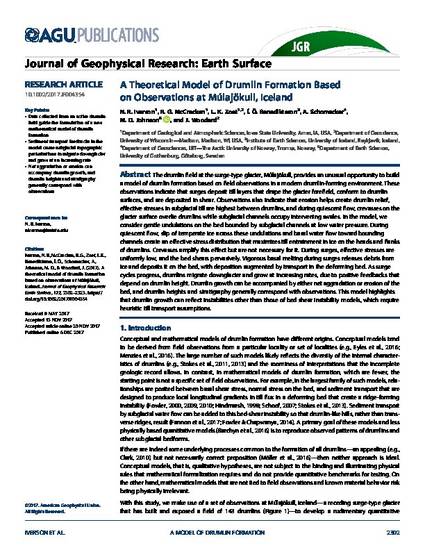
The drumlin field at the surge‐type glacier, Múlajökull, provides an unusual opportunity to build a model of drumlin formation based on field observations in a modern drumlin‐forming environment. These observations indicate that surges deposit till layers that drape the glacier forefield, conform to drumlin surfaces, and are deposited in shear. Observations also indicate that erosion helps create drumlin relief, effective stresses in subglacial till are highest between drumlins, and during quiescent flow, crevasses on the glacier surface overlie drumlins while subglacial channels occupy intervening swales. In the model, we consider gentle undulations on the bed bounded by subglacial channels at low water pressure. During quiescent flow, slip of temperate ice across these undulations and basal water flow toward bounding channels create an effective stress distribution that maximizes till entrainment in ice on the heads and flanks of drumlins. Crevasses amplify this effect but are not necessary for it. During surges, effective stresses are uniformly low, and the bed shears pervasively. Vigorous basal melting during surges releases debris from ice and deposits it on the bed, with deposition augmented by transport in the deforming bed. As surge cycles progress, drumlins migrate downglacier and grow at increasing rates, due to positive feedbacks that depend on drumlin height. Drumlin growth can be accompanied by either net aggradation or erosion of the bed, and drumlin heights and stratigraphy generally correspond with observations. This model highlights that drumlin growth can reflect instabilities other than those of bed shear instability models, which require heuristic till transport assumptions.
Available at: http://works.bepress.com/neal-iverson/44/

This article is published as Iverson, N. R., R. G. McCracken, L. K. Zoet, Í. Ö. Benediktsson, A. Schomacker, M. D. Johnson, and J. Woodard. "A Theoretical Model of Drumlin Formation Based on Observations at Múlajökull, Iceland." Journal of Geophysical Research: Earth Surface 122, no. 12 (2017): 2302-2323. DOI: 10.1002/2017JF004354. Posted with permission.